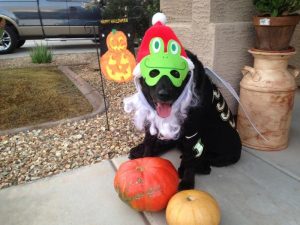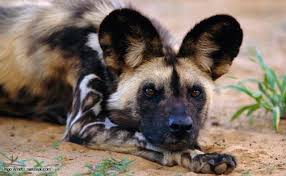From Tricks to Treats: How to Keep Your Pets Safe on Halloween

Most everyone loves Halloween. Between the costumes and all the treats you can eat, it’s a great time for children, adults and pets. There’s ways to ensure your pets stay safe. From dangerous costume materials to toxic foods, it’s important to keep your pets out of harm’s way.
According to the ASPCA’s “Halloween Safety Tips,” remember to keep all that tasty candy away from pets. Your pets may want those tasty treats, but they can be downright deadly to them, and that’s real scary! “Chocolate in all forms—especially dark or baking chocolate—can be very dangerous for cats and dogs, and sugar-free candies containing the artificial sweetener xylitol can cause serious problems in pets,” according to the ASPCA. If you fear your pet has gotten into anything toxic, contact your veterinarian or immediately contact the ASPCA Poison Control Center at (888) 426-4435.
You may not realize the dangers Halloween decorations can pose to your pets. Be careful of wires and even a carved jack-o-lantern. According to the ASPCA, “pets can easily knock over a lit pumpkin and start a fire.” Also remember that kittens are curious and easily can get burned by candle flames. The ASPCA also suggests keeping your pets away from pumpkins and “decorative corn.” They may not be totally toxic to pets but they can cause an upset stomach.
Your dog may look absolutely adorable in that Batman costume. And kitty may wow them in a Wonder Woman getup. However, costumes are not for every pet and “may cause undue stress.” Unless you know your pet is up for that costume, the ASPCA doesn’t recommend it. If the costume is a go, the ASPCA says:
• Ensure the costume does not limit “movement, sight or ability to breathe, bark or meow.”
• Ensure the costume does not have any “small, dangling or easily chewed-off pieces” that could cause choking.
• Ensure the costume fits correctly so that it does not “get twisted on external objects or your pet, leading to injury.”
Keep your pet calm during the activities of Halloween, including when strangers come to the door. If your pets get too stressed out, it’s best to leave them in another room. Always “be sure that your dog or cat doesn’t dart outside,” and that they are wearing ID at all times, just in case, according to the ASPCA.
October is Dedicated to the Welfare and Care of Domestic and Wild Animals

October is National Animal Safety and Prevention Month, an entire month dedicated to the welfare of animals, both domestic and wild. National Animal Safety and Prevention Month was created by the PALS Foundation, which was founded to help “people and animals coexist in a way that benefits all nature,” according to Dog.com. This special month was “dedicated to promoting the safe practices of handling and caring for both domestic and wild animals.” It recognizes the importance of animals and the roles they play in our lives, even to those without pets. It hopes to ensure “that they are treated kindly and with the respect and care they deserve.”
According to Dog.com, there are a variety of ways in which to participate in National Animal Safety and Prevention Month. Here are some ideas:
- Tend to the needs of your own pets, starting with ensuring they are microchipped for their safety. Make sure they wear ID tags at all times.
- Your home has many items that can be dangerous or toxic to pets. Pet proof your home so your pets can’t get into anything that is harmful.
- Create a “disaster escape plan in case you ever need to evacuate your pets quickly from the home.”
For those who don’t have pets, here are some great ideas:
- Volunteer at a local shelter
- Foster a pet
- Donate money
- Donate supplies to shelters
It’s a great time to get others involved and spread the word, especially for those who don’t know about National Animal Safety and Prevention Month. Contact your local newspaper, TV and radio stations and tell them about it and ask what they will do to help promote and bring awareness. The more people who know, the more who can get involved to help ensure that safety practices for animals are in place this month and throughout the year.
Foods to Keep Away from Pets to Ensure Their Health
Every year, usually beginning in October due to Halloween and other upcoming holidays, we are reminded once again of toxic foods and pets. It’s a good reminder to keep a list handy now and throughout the year.
If we let our pets have the run of the house, they would eat anything and everything. However, that would be a very bad idea. Very often the foods we love to eat can be very dangerous to our pets and sometimes can even cause death. So it’s best to know what foods are OK and those that are not.
Remember, it is always a good idea to discuss food choices with your veterinarian. In addition, the Humane Society of the United States provides a list of foods that may be poisonous for your pets:
- Alcoholic beverages
- Apple seeds
- Apricot pits
- Avocados
- Cherry pits
- Candy (particularly chocolate—which is toxic to dogs, cats, and ferrets—and any candy containing the toxic sweetener Xylitol)
- Coffee (grounds, beans, and chocolate-covered espresso beans)
- Garlic
- Grapes
- Gum (can cause blockages and sugar free gums may contain the toxic sweetener Xylitol)
- Hops (used in home beer brewing)
- Macadamia nuts
- Moldy foods
- Mushroom plants
- Mustard seeds
- Onions and onion powder
- Peach pits
- Potato leaves and stems (green parts)
- Raisins
- Rhubarb leaves
- Salt
- Tea (because it contains caffeine)
- Tomato leaves and stems (green parts)
- Walnuts
- Xylitol (artificial sweetener that is toxic to pets)
- Yeast dough
If you feel your pet has gotten into any food that may be poisonous, contact the ASPCA Animal Poison Control Center (APCC), which is available 24 hours a day, 365 days a year by calling (888) 426-4435. (A fee many apply.)


Recent Comments